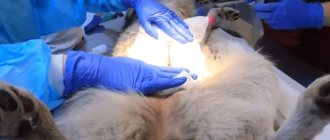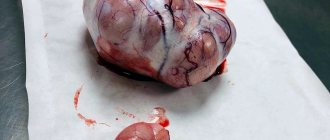Owners often have doubts about whether such a radical intervention as sterilization of dogs is necessary? This is due to the lack of objective information in society and the erroneous assessment of sterilization as a human whim without taking into account the interests of the animal.
Indeed, such a decision—whether sterilization of dogs is necessary—requires a reasoned approach. Gender, age, breed, living conditions and medical indications are taken into account. Based on the examination of the dog, weighing the effect of sterilization and possible risks, further actions are taken.
The general concept of “sterilization of dogs” implies the temporary or irreversible prevention of reproduction of a bitch and a dog.
Pros and cons of the operation
The benefits of sterilizing dogs include:
- absence of unwanted offspring, estrus and false pregnancies in females;
- reducing the risk of breast tumors and inflammatory processes of the genitourinary system;
- reduction in aggression and anxiety;
- getting rid of the obsessive attention of males while walking;
- increase in life expectancy.
The disadvantages of sterilizing dogs include the risks of pathological conditions:
- hypothyroidism;
- obesity, diabetes;
- urinary incontinence.
Answer
Surgery performed under anesthesia is stressful for the animal’s body. To minimize the negative consequences of the operation, you should trust your pet only to a trusted veterinarian.
Sterilization is a procedure that results in a dog permanently losing the ability to reproduce. Due to the guaranteed exclusion of unwanted pregnancy, the operation is highly popular. The veterinarian performs the intervention under general anesthesia and, unlike castration, leaves the genitals intact. Sterilization involves surgically disrupting the functioning (ligation of the canals) of the gonads, which are responsible for the reproductive function of the body. The operation is considered exclusively “female”, which is fundamentally incorrect, since it is performed on animals of both sexes.
Types of sterilization
Sterilization of dogs is a abdominal operation that is performed under general anesthesia. There are several methods:
- tissue dissection along the white line of the abdomen. This is a classic technique. If sterilization is carried out before the first heat, then only the dog's ovaries are removed;
- removal of not only the ovaries, but also the uterus. The technique is used for dogs that have already given birth. Otherwise, in the future there is a risk of various pathologies of the uterus and repeated emergency surgery;
- side cut. This is how stray dogs are usually sterilized. After the animal recovers from anesthesia, it is released outside. This is a minimally invasive technique, but with such an incision there is no way to assess the current condition of other organs, so surgeons prefer to make an incision along the white line of the abdomen;
- laparoscopy. A modern, minimally invasive sterilization method that requires expensive, sophisticated equipment and trained personnel.
Dogs can also be sterilized using chemical methods. Instead of surgery, regular injections of hormonal drugs are made or a subcutaneous Suprelorin implant is inserted. Chemical sterilization methods cause temporary loss of sexual function. Hormonal injections must be done constantly, which can lead to the development of a number of complications.
At what age do dogs need to be sterilized?
The question of when to spay a dog involves the safest age for the operation. It is not recommended to carry it out before 8 months of age. This can lead to stunted growth and development of the body. Sterilization of dogs is effective from 8 months to 1 year. Then it minimizes all negative consequences.
Of all the methods, laparoscopic sterilization of dogs is considered a fairly simple operation. It is very well tolerated by animals.
Postoperative care is of great importance. It includes treatment of sutures, drug therapy, and a gentle diet.
Neutering a dog is a decision that the owner makes. It is important that it takes into account maintaining the health and increasing the life expectancy of the pet.
Preparing for surgery
You need to stop feeding your dog at least 6-8 hours beforehand. Water must be abandoned 4 hours in advance. Before the operation, the animal must be examined to eliminate possible risks associated with anesthesia. It is also advisable to first do an ultrasound of the reproductive organs and take blood tests (biochemical, general).
What is chemical castration
This type of castration involves a temporary, reversible cessation of sexual desire in dogs. Its use is advisable for individuals with a high anesthetic risk (elderly, sick, with weakened immune systems), as well as for representatives of hunting, service and guard breeds to improve their working qualities. Infertility does not occur immediately, but 4-5 weeks after the activation of the administered drug, which blocks the production of sex hormones. Validity period: 6-12 months.
The principle of chemical castration is similar to chipping: a drug is injected under the dog’s skin (in the withers area) using a syringe, which inhibits reproductive function and suppresses testosterone levels in males. After the expiration date or removal of the capsule, the dog’s sexual functions are restored.
The most common drug intended for temporary castration is the subcutaneous biocompatible implant Suprelorin, available in two versions: 4.7 mg and 9.4 mg of deslorelin. They differ in duration of action - 6 and 12 months, respectively.
Once under the dog's skin, the active component deslorelin, being absorbed very slowly but continuously, stops the production of testosterone, and the effect of suppressing libido is reversible even after repeated use of the implant.
To maintain effectiveness, Suprelorin is recommended to be used every 6-12 months (depending on the deslorelin content). There is no need to remove it. If treatment must be stopped, the implant is detected using ultrasound and removed surgically.
If the dog's weight is less than 10 or more than 40 kilograms, it is necessary to consult a veterinarian regarding the possibility of using the drug.
Suprelorin is widely used in the European Union, Australia, and New Zealand, but in Russia the implant is used infrequently. This is due to its high cost and low availability. Today, the global market of veterinary drugs does not offer alternatives in terms of safety, effectiveness, quality and the ability to restore sexual functions.
Complications after sterilization in dogs, does behavior change after surgery?
The animal's behavior is definitely
towards more obedient, more devoted, calm. And, this is quite a big plus in the matter of sterilization.
At what age is it best to sterilize an animal?
Sterilization of an animal is best at the age of four to five months.
, this is if you take small breeds of dogs.
As for larger breeds, this is the age of six months,
that is,
until the animal’s first heat . It has been proven that a dog needs at least one litter of puppies to be healthy. In fact, there is absolutely no need for this. Yes, of course, if you deliberately take an animal to breed puppies, this may make sense, but in general, no. Likewise, it is a myth that dogs that are sterilized live less than normal, being boring, lethargic, and lacking any initiative.
In reality, everything is completely different: the animal that has undergone the sterilization procedure has a chance to live twenty percent longer
.
As for the issue of excess weight, it directly relates to the fact that the pet is overfed by its owners. But, even knowing the facts, there will always be those who will flatly refuse to sterilize their animal, preferring to replace it with a course of hormonal therapy, which, on the contrary, will pose a higher danger for the pet.
It should also be taken into account that dogs that have undergone sterilization much less susceptible to certain stress factors.
. Their appetite does not disappear, but improves, so there is absolutely no need to overfeed your animal. This would be a grave mistake.
- You can perform a sterilization operation:
- in a veterinary clinic;
- Houses.
Scientifically proven effects of castration and sterilization
Preface
Determined to gain a thorough understanding of this extremely complex topic, Dr. Sanborn carefully and unbiasedly reviewed a vast amount of veterinary medical literature.
Her retrospective study was based on more than fifty books and research reports in the field of studying the consequences of sterilization of females and castration of males, separately in each area. The discovered data is so shocking that it simply cannot be ignored. Castration of male dogs has been found to increase the risk of developing osteosarcoma, hemangiosarcoma, hypothyroidism and other less common diseases. In light of this, it seems completely irresponsible to suppress these facts, leaving dog lovers in the dark about the consequences of castration. With regard to sterilization of female dogs, the situation looks even more complicated, which leads to the need to carefully study the indications for this operation in each individual case. Sterilization should under no circumstances be recommended as a standard medical procedure.
It is worth noting that the author does not make sensational generalizations in his study. Rather, it asks us to carefully collect all information regarding the health and hereditary diseases of a particular animal. The decision to carry out a sterilization or castration operation should be made not only taking into account the gender, age, specifics of the breed, but even the current and future conditions of keeping and training the animal.
This important report will help veterinarians and dog owners make the right, informed decision in each case. What more could you ask for?
Larry S. Katz, PhD Associate Professor and Chair Animal Sciences Rutgers University New Brunswick, NJ 08901
Introduction
Dog owners in America are often advised to spay or neuter their pets on the basis of health concerns. Experts talk about a number of benefits of owning a spayed or neutered dog, without any concern for any evidence of the reality of these benefits.
When discussing the impact of spaying or neutering on a dog's health, the possible risks are usually not even mentioned by the veterinarian. Only sometimes the doctor cites a few minor side effects, keeping silent about the most serious consequences.
In writing this work, the goal was to summarize all the significant risks and benefits from a health point of view from spaying or neutering a dog, information about which can be found in the veterinary literature and specialized studies. Please note that this does not discuss sterilization as a means of population control or the effect of castration on dog behavior.
Much of the information presented in this paper is obtained by summarizing information contained in retrospective studies of dogs, in other words, based on specific existing data. Only a small amount of information is prognostic in nature and also obtained from relevant studies.
Brief summary of results
An open-minded examination of the veterinary medical literature reveals the complexity of the current state of affairs regarding the long-term risks and benefits that arise from spaying or neutering a dog. There is compelling evidence of both the positive and negative effects of spaying or neutering on a dog's health. All this shows how much we really do not yet understand this topic.
Positive consequences of castration:
- Castration eliminates the small risk (approximately <1%) of death from testicular cancer;
- Castration reduces the risk of non-cancer prostate diseases;
- Castration reduces the risk of perianal fistulas;
- Neutering supposedly reduces the risk of diabetes (data uncertain).
Negative consequences of castration:
- If carried out before the dog reaches the age of 1 year, castration significantly increases the risk of osteosarcoma, that is, bone cancer, a very common disease among large dogs with a poor prognosis for treatment;
- Castration increases the risk of cardiac hemangiosarcoma by 1.6 times;
- Castration increases the risk of developing hypothyroidism by 3 times;
- Castration increases the risk of developing progressive cognitive impairment similar to dementia;
- Castration 3 times increases the risk of developing obesity, which is common in many dogs and leads to a number of related problems;
- Castration quadruples the small (<0.6%) risk of developing prostate cancer;
- Castration doubles the small (<1%) risk of urinary tract cancer;
- Castration increases the risk of developing musculoskeletal diseases;
- Castration increases the risk of adverse reactions to vaccinations.
Overall, there appears to be no compelling reason to neuter most male dogs to prevent future health problems, especially before they reach puberty. In the vast majority of cases, the host of health problems associated with castration can significantly exceed the possible benefits of this operation.
The situation with sterilization of female dogs is much more complicated. In many, but not all cases, the total number of benefits associated with sterilization may be greater than the number of problems associated with the operation. In general, it can be said that whether the overall effect associated with sterilization is beneficial or detrimental appears to depend on the age of the dog and the relative risk of developing certain diseases within a particular breed.
Positive effects of sterilization:
- When tested before the dog is 2.5 years of age, neutering significantly reduces the risk of mammary tumors, the most common cancer in female dogs;
- Sterilization virtually eliminates the risk of pyometra (accumulation of pus in the uterine area), which affects up to 23% of unsterilized dogs (about 1% of unsterilized dogs die from pyometra);
- Sterilization reduces the risk of perianal fistula formation;
- Sterilization eliminates the very small (≤0.5%) risk of uterine, cervical and ovarian cancer.
Negative consequences of sterilization:
- If carried out before the dog reaches 1 year of age, neutering significantly increases the risk of osteosarcoma (bone cancer), a very common disease among large dogs with a poor prognosis for treatment;
- Neutering increases the risk of splenic hemangiosarcoma by 2.2 times and the risk of cardiac hemangiosarcoma by more than 5 times (these diseases are very common in some breeds and are the leading cause of death in these dogs);
- Sterilization increases the risk of developing hypothyroidism by 3 times;
- Sterilization increases the risk of obesity by 1.6-2 times;
- Spaying is a cause of incontinence, which affects 4 to 20% of spayed female dogs;
- Sterilization increases the risk of persistent or recurring urinary tract infections by 3-4 times;
- Spaying increases the risk of developing a folded or juvenile vulva, vaginal dermatitis, and vaginitis, especially in female dogs that were spayed before puberty;
- Sterilization doubles the small risk (<1%) of urinary tract tumors;
- Sterilization increases the risk of developing musculoskeletal diseases;
- Sterilization increases the risk of adverse reactions to vaccinations.
Research results
This section provides information about diseases or special conditions that have been studied in connection with spay or neuter.
Complications after surgery
All operations, regardless of complexity, carry a certain risk of complications, such as adverse reactions to anesthesia, bleeding, inflammation, infection, and so on. A complication is understood as an immediate or soon after operation reaction of the body to this intervention and is a direct consequence of such an intervention. Complications do not include consequences that occur over time and are studied in separate studies.
According to data obtained in one of the educational veterinary clinics, where the occurrence of complications after castration or sterilization was carefully monitored, intraoperative complications occurred in 6.3% of operations performed, postoperative ones in 14.1% of cases, and the total number of operations with complications reached 20. 6%.
According to other studies, the total number of sterilization operations with complications reached 17.7%, castration up to 23%. Research by the Canadian Association of Private Veterinarians, in turn, showed rates of 22% and 19% of spay and neuter operations with complications.
Serious complications, such as infections, abscesses, suture ruptures, and so on, are recorded in 1-4% of cases, of which 90% occur in sterilization operations and 10% in castration.
The mortality rate due to complications following spay or neuter is relatively low, only about 0.1%.
Prostate cancer
One of the most compelling arguments in favor of castration, which is given in most public sources, is the significant reduction or even complete elimination of prostate risk in male dogs as a result of this operation. This statement is not without foundation if we draw a direct analogy between a dog and a person: indeed, in men there is a certain connection between testosterone levels and prostate cancer. There is no evidence of such a connection in dogs. Moreover, there is very strong evidence to the contrary.
Various long-term epidemiological studies conducted without the use of control groups often yield results that are directly opposite to each other. Some confirm an increased risk of prostate cancer in unspayed male dogs, while others deny it.
Recent extensive studies have made it possible to avoid errors in the interpretation of results precisely through the use of control groups. Two independent groups of scientists worked in Europe and the United States, studying local dog populations. In both cases, the researchers showed that the risk of prostate cancer in neutered dogs is 4 times higher than in non-neutered ones.
Based on the results of the work, scientists suggested that castration itself does not lead to prostate cancer; rather, it does not prevent the development of the tumor. “We found that the most common prostate cancer in dogs is ductal or urothelial in nature. The relatively low incidence of prostate cancer in uncastrated male dogs may be explained by the protective role of ovarian hormone against prostate carcinoma. It cannot be ruled out that changes in the external environment of the prostate as a result of the action of hormones may have an indirect negative effect on tumor development.”
These hypotheses certainly deserve further attention in the future. Unlike humans, prostate cancer is not very common in dogs. Considering that autopsy confirmed its presence in only 0.6% of dogs, the risk of its development cannot be considered as a serious factor when deciding on castration.
Testicular cancer
Since castration completely removes the testicles, the risk of testicular cancer is reduced to zero (provided, of course, that the operation was performed before the disease occurred). These rates should be compared with the risk of testicular cancer in non-neutered dogs. Testicular cancer is quite common among older dogs, affecting about 7% of the total number of unneutered male dogs.
However, the prognosis for treatment of testicular tumors is very favorable given the low rate of development of metastases, so testicular cancer is a very rare cause of death.
For example, according to a Purdue University study on the health of the Golden Retriever breed, the number of deaths from testicular cancer is so small that it was not even included in the list of significant causes of “Potential years of life lost due to veterinarian-certified causes of death,” even though that 40% of males were uncastrated.
Moreover, the success rate for testicular cancer treatment in Golden Retrievers was 90.9%. These findings are consistent with other studies that have found a 6-14% risk of developing testicular cancer metastases in dogs overall. The high percentage of cases of complete cure for testicular cancer, combined with the incidence of the tumor, suggests that the probability of death from this disease in unspayed male dogs is less than 1%.
Overall, it can be argued that although the risk of testicular cancer is the most common argument cited by proponents of neutering, the negative impact of this disease on the lifespan of dogs is clearly not strong enough to justify surgery.
Exceptions may be unilateral or bilateral cryptorchid, since the risk of testicular tumors located in the abdominal cavity is 13.6 times higher than in healthy dogs. In addition, such tumors are much more difficult to detect during a routine medical examination.
Osteosarcoma (bone cancer)
Comprehensive multibreed studies of dogs have found that the risk of osteosarcoma in spayed/neutered dogs is twice as high as in those animals that have not undergone such surgery.
These risks were further studied more thoroughly using the example of Rottweilers, known for their relatively high breed predisposition to osteosarcoma. The dogs were divided into groups depending on the age at which sterilization or castration was performed.
It turned out that those dogs that were spayed or neutered before they reached the age of one year are at the highest risk of developing bone cancer. In this case, males are 3.8 times more likely and females are 3.1 times more likely to suffer from osteosarcoma than those dogs that have not undergone these operations. The breed predisposition of Rottweilers and early spaying or castration in combination lead to the fact that 28.4% of males and 25.1% of females develop osteosarcoma.
These findings are consistent with earlier multibreed studies focusing on age at spay or neuter surgery. Based on these studies, it can be concluded that spaying or neutering dogs under one year of age significantly increases the risk of osteosarcoma.
Sex hormones are known to influence the maintenance of skeletal structural integrity and weight stability. By analogy with this, scientists have suggested the presence of a cause-and-effect relationship in the case of osteosarcoma: in their opinion, sex hormones can be considered as a limiting factor in the development of bone cancer.
The risk of osteosarcoma increases as the breed size of the dog increases, and especially height. Osteosarcoma is a common cause of death in medium, large and giant breeds. While osteosarcoma is the third most common cause of death in golden retrievers, this figure is even higher for other large and giant breeds.
Given the poor prognosis for treatment of osteosarcoma and the frequency of detection of this disease in dogs of many breeds, it is safe to say that spaying or neutering dogs of medium, large and giant breeds before they reach sexual maturity significantly increases the risk of death from this disease.
Breast tumor
Mammary tumors are the most common type of tumor in unspayed female dogs, accounting for 53% of the total number of malignant tumors. These findings come from studies conducted in Norway, where sterilization is much less common than in the United States.
50-60% of all breast tumors are malignant with a high risk of metastases. Estrogen receptors have been found in mammary tumors in dogs, and published studies show that the relative risk (odds ratio) of developing mammary cancer in spayed versus unspayed bitches depends on how many heats the bitch had before spaying:
| Number of heats before sterilization | Odds ratio |
| None | 0,005 |
| 1 | 0,08 |
| 2 or more | 0,26 |
| Unsterilized | 1,0 |
Same data, but presented differently:
| Age of sterilization | Odds ratio |
| ≤ 29 months | 0,06 |
| ≥ 30 months | 0,40 |
| Unsterilized | 1,0 |
Please note that these are RELATIVE risks. The results of these studies appear in many articles, but are often incorrectly presented as absolute risks.
A similar reduction in the risk of breast cancer was found in women under 40 years of age whose bodies stopped producing estrogen as a result of “induced menopause,” confirming the influence of estrogen on the development of breast cancer.
Breast cancer was found to be the 10th most common cause of years of life lost in golden retrievers, although 86% of the female dogs in the study were spayed at an average age of 3.4 years. Considering that the vast majority of mammary cancer cases occur in female dogs, it can be assumed that this disease is the 5th most common cause of lost years of life in Golden Retrievers. This figure would be even higher if more Goldens remained unspayed until they reached 30 months of age.
Breeds with a high risk of breast cancer also include boxers, cocker spaniels, springer spaniels and dachshunds. According to the results of a study of a large group of Boxer bitches, consisting mainly of unsterilized individuals, the probability of developing mammary gland cancer in representatives of this breed is 40% when they reach the age of 6-12 years.
There is also evidence that purebred dogs have a higher risk of mammary cancer than mixed-breed dogs, and purebred dogs with a high inbreeding coefficient have a much higher risk than purebred dogs with a low inbreeding coefficient. However, additional research is needed to confirm these indicators.
Summarizing the data obtained, it can be argued that sterilization significantly reduces the risk of developing mammary gland cancer, and the fewer heats a bitch had before she reached the age of 30 months, the lower her risk of developing this disease.
Uterine, cervical and ovarian cancer
Cancer of the uterus or cervix is very rare in dogs, accounting for only 0.3% of the total number of tumors. Sterilization completely eliminates the risk of these diseases, but it should be noted that this risk is only 0.5%. It can be argued that, although the risk of developing uterine, cervical or ovarian cancer is completely eliminated as a result of sterilization, the degree of risk is not so great as to be a truly serious reason for undergoing surgery.
Urinary tract cancer
In retrospective studies of age-matched dogs, the risk of developing urethral or bladder tumors was found to be twice as high in spayed or neutered dogs as in non-spayed dogs. These tumors are almost always malignant but are uncommon, accounting for less than 1% of all tumors in dogs. Thus, the risk of urinary tract tumors is not high enough to seriously influence the decision to spay or neuter.
An increased risk of developing urinary tract cancer is seen in Airedales, Beagles and Scotch Terriers, while the risk is lower than average in German Shepherds.
Hemangiosarcoma
Hemangiosarcoma is the most commonly diagnosed type of tumor in dogs. It is a leading cause of death in some dog breeds, such as the Saluki, French Bulldog, Irish Water Spaniel, Flat-Coated Retriever, Golden Retriever, Boxer, Afghan Hound, English Setter, Scotch Terrier, Boston Terrier, Bulldog and German Shepherd.
In a matched control study of dogs, the risk of splenic hemangiosarcoma was found to be 2.2 times higher in spayed bitches than in non-spayed bitches.
A retrospective study of risk factors for cardiac hemangiosarcoma showed that in spayed female dogs the risk of this disease is more than 5 times higher than in non-spayed dogs, and in neutered male dogs the risk of cardiac hemangiosarcoma is 1.6 times higher than in non-spayed dogs.
Obviously, the increased risk of hemangiosarcoma should be taken into account when deciding whether to spay or neuter, especially in cases where we are talking about a breed with a high degree of predisposition to the development of this type of tumor.
Hypothyroidism
Research has found an association between spaying or neutering and a threefold increase in the risk of hypothyroidism in dogs that have undergone surgery compared to dogs that have not had surgery.
Scientists have suggested a certain cause-and-effect relationship. In the work of Fr. This effect may likely explain the relationship between spaying or neutering and hypothyroidism in dogs.
Hypothyroidism causes obesity, lethargy, hair loss, and reproductive abnormalities in dogs. Hypothyroidism can occur at any age; studies show that 1 in 4 Golden Retrievers, 1 in 3 Akita Inus and 1 in 13 Great Danes are at risk.
Obesity
Due to changes in metabolism, spayed or neutered dogs are more overweight or obese than non-spayed dogs. One study found a twofold increase in the risk of obesity in spayed female dogs compared to unspayed female dogs. Another study found that spayed or neutered dogs were 1.6 times (females) or 3 times (males) more likely to be obese than non-spayed dogs, and 1.2 times (females) or 1.5 times (males) more likely to be obese. are more likely to gain excess weight than those without surgery.
A study of veterinary practices found that 21% of dogs in the UK are obese.
Obesity or being overweight in dogs is associated with a variety of health problems. Overweight dogs are more likely to be diagnosed with hyperadrenocorticism, cruciate ligament rupture, hypothyroidism, lower urinary tract diseases, and oral diseases. Dogs that are obese are more likely to be diagnosed with diabetes, pancreatitis, and neoplasia (tumors).
Diabetes
Some data show a twofold increase in the risk of developing diabetes in neutered male dogs, but other studies do not find a significant change in the risk of developing this disease due to neutering. These same studies found no relationship between sterilization and the risk of diabetes.
Adverse reactions to vaccination
A retrospective cohort study of adverse reactions to vaccination in dogs including allergic reactions, urticaria, anaphylaxis, cardiac arrest, cardiovascular shock and sudden death was conducted. It was found that adverse reactions were 30% more common in spayed female dogs than in non-sterilized ones, and 27% more common in neutered male dogs than in non-spayed male dogs. Researchers are discussing possible cause-and-effect relationships, including the role of sex hormones in the body's ability to mount an immune response to vaccination.
Toy and small breeds are at greatest risk of adverse reactions to vaccinations. Boxers, English bulldogs, Lhasa Apsos, Weimaraners, American Eskimo dogs, golden retrievers, basset hounds, Welsh corgis, huskies, Great Danes, Labradors, Dobermans, pit bull terriers and Akita Inus are also at high risk of such reactions. Mestizos were found to be less likely to experience adverse reactions to vaccinations, and the study authors blame genetic heterogeneity as a factor.
Urogenital disorders
Urinary incontinence is common in spayed female dogs and can occur either soon after spaying or several years after surgery. Incidence rates in various studies range from 4% to 20% in spayed female dogs, compared to 0.3% in non-spayed females.
Urinary incontinence is so strongly associated with sterilization that it is even called “sterilization incontinence.” It is caused by improper functioning of the urethral sphincter, although the biological mechanism of this disorder is unknown. Most (but not all) cases of urinary incontinence are treatable, but in many cases treatment must be continued throughout the dog's life.
A retrospective study found that chronic or recurrent urinary tract (bladder) infections are 3 to 4 times more likely in spayed female dogs than in non-spayed female dogs. Another retrospective study found that female dogs spayed before 5.5 months were 2.76 times more likely to develop chronic or recurrent urinary tract infections than dogs spayed after 5.5 months.
Depending on the age at which the operation was performed, sterilization is a cause of abnormal development of the external genitalia. Research has shown that spayed female dogs have an increased risk of developing a folded or juvenile vulva, vaginal dermatitis, vaginitis, and urinary tract infections. If the female dog was spayed before puberty, the risk of developing these diseases becomes even higher.
Pyometra (inflammation of the uterus)
According to pet insurance companies, in Sweden (where spaying is not very common) 23% of all female dogs under the age of 10 develop pyometra. Bernese Mountain Dogs, Rottweilers, Rough Collies, Cavalier King Charles Spaniels and Golden Retrievers are recognized as high risk breeds for this condition.
Bitches that are not untied and have never given birth to puppies are especially at increased risk of developing pyometra. In rare cases, spayed female dogs may develop the so-called “stump pyometra” due to the fact that the uterus was not completely removed during the operation.
Pyometra is usually completely curable with surgery or medication, however, in 4% of cases it leads to the death of the dog. Given the prevalence of this disease, it can be estimated that approximately 1% of unspayed female dogs may die as a result of inflammation of the uterus.
Perianal fistulas
Males suffer from perianal fistulas twice as often as females, and the risk of this disease in dogs that have been spayed or neutered is lower than in those that have not been operated on. German Shepherds and Irish Setters suffer from perianal fistulas more often than other breeds.
Non-oncological diseases of the prostate gland
As older male dogs age, the risk of developing benign prostatic hypertrophy (BPH, enlarged prostate) increases. This disease affects more than 80% of uncastrated male dogs over 5 years of age. For the most part, BPH does not cause any discomfort, except that in some cases it becomes difficult for the dog to defecate or urinate.
Castration prevents the development of BPH. If surgery is performed after prostate enlargement, the enlarged prostate begins to shrink relatively quickly.
The development of BPH is related to other prostate problems such as infections, abscesses and cysts, which can sometimes lead to serious consequences.
Diseases of the musculoskeletal system
When studying beagles, it turned out that surgical removal of the ovaries, which is performed during sterilization, is the cause of an increase in the rate of deformation of the ilium (pelvic) bone. Based on this, scientists have suggested that sterilization leads to an increased risk of developing hip dysplasia. In addition, sterilization has been found to cause a decrease in bone mass in the spine.
Spaying or neutering immature dogs delays the closure of the growth plates in the bones, which continue to grow during this period. This delay is why the bones of spayed or neutered dogs take much longer to form than those that have not undergone surgery at all or have had surgery after puberty. Since the growth plates in different bones close at different times, castration or neutering done when some plates have already closed and others have not yet results in a dog's skeleton with unnatural proportions, which is likely to negatively affect the dog's health. performance and durability of joints.
Spaying and neutering are associated with a twofold increase in the risk of cruciate ligament rupture. Probably the main reason here lies in the increased risk of obesity.
Spaying and neutering dogs before they are 5.5 months of age is associated with a 70% increased risk of developing hip dysplasia compared to dogs that have surgery after they are 5.5 months of age. According to the researchers, “it is possible that the increase in bone length as a result of early castration led to changes in the shape of the joints, which could cause the development of hip dysplasia.”
A study of the health of Airedale dogs found that spayed and neutered dogs were much more likely to suffer from hip dysplasia, as well as “other musculoskeletal disorders,” compared to dogs that had not been operated on.
However, the results of this study may be influenced by extraneous factors that were not properly taken into account, such as the possibility that the dogs were spayed or neutered because they suffered from dysplasia or other musculoskeletal disorders.
Studies have shown that dogs spayed or neutered 6 months before diagnosis of hip dysplasia are 1.5 times more likely than dogs that have not been operated on to develop the clinical form of this disease.
According to other studies, dogs that have been spayed or neutered are 3.1 times more likely to suffer a luxating patella than dogs that have not been spayed.
Age-related cognitive impairment
Neutered males and neutered females have an increased risk of developing mild to moderate age-related cognitive impairment compared to non-neutered dogs. There were not enough spayed female dogs in the study to accurately assess the risk.
Age-related cognitive decline includes loss of orientation in the home and outdoors, changes in behavior towards family members, loss of learning skills, and disturbances in the sleep-wake cycle.
The researchers state: “The findings are consistent with ongoing research into the neuroprotective role of testosterone and estrogen at the cellular level and the role of estrogen in preventing the development of Alzheimer's disease in women. It may be hypothesized that estrogen plays a similar protective role in unspayed bitches, but at the time of this study it was not possible to study a sufficient number of unspayed bitches to test this hypothesis.”
Conclusion
One thing is certain: the overwhelming amount of information about the consequences of castration and sterilization available in the public domain is extremely one-sided. Most sources provide information that is unverified or not supported by serious evidence. Instead of helping pet owners understand this issue and make an informed decision, such information further confuses and contributes to a lack of understanding of the full consequences of such operations.
The common practice of spaying or neutering dogs when they reach 6 months of age, as well as the modern tendency to perform these operations at an even earlier age, appear to result in dogs developing diseases that could have been avoided either by undergoing surgery after puberty. or, as is the case with most male dogs, refusing to undergo it if there are no compelling medical indications for it.
The overall risk versus benefit of spaying or neutering over the long term will vary from dog to dog. In each individual case, when deciding on surgery, it is necessary to take into account both objective indicators, such as breed, age or gender, and many non-medical factors. Universal recommendations for all dogs without exception are not confirmed by studying the veterinary medical literature.
Original: Long-Term Health Risks and Benefits Associated with Spay / Neuter in Dogs
© Laura J. Sanborn, MS, May 14, 2007. Translation and adaptation: A. Smirnov, 2022.
Liked? Subscribe to my YandexZen channel and see pictures on Instagram.
© 2019-2022 Alexander Smirnov @kinologsmirnov.ru. Respect the work of the author: copying any part of the material is possible only with indication of authorship and a link to the source.
Indications
Sometimes the owner has no choice, and surgery is necessary for an adult pet for medical reasons. The advice of veterinarians is to sterilize an animal over 7 years old in order to reduce the risk of developing cancer and to prevent other dog diseases.
A female dog with prolonged heat and severe blood loss is being prepared for emergency surgery. Factors that influence a doctor’s indications for sterilization include hormonal disorders, miscarriages, illness, and non-developing pregnancy.
What anesthesia is used to castrate a dog?
Today, three types of anesthesia are used in veterinary medicine:
- general anesthesia - after general anesthesia is administered, the animal falls into deep sleep. It sees, hears and feels nothing. Only the heart functions. General anesthesia is considered the most dangerous type of anesthesia, since an incorrectly calculated dose will lead to disastrous consequences: due to excess, the heart may stop; due to insufficient dosage, the dog will wake up during surgery;
- epidural anesthesia - when epidural anesthesia is administered, the animal is conscious, but it is completely immobilized and does not feel pain. This type of anesthesia is an injection into the spine. Epidural anesthesia is a more gentle type of anesthesia compared to general anesthesia. Used in animals with a weak cardiovascular system;
- local anesthesia - during local anesthesia the dog is conscious. She hears everything, can move, but does not experience pain. This type of anesthesia is suitable for animals that have contraindications to general anesthesia.
Sometimes doctors combine general anesthesia with local anesthesia to make the postoperative period less painful.
Contraindications
Sterilization is not carried out if the pet has decompensated somatic diseases and untreated severe injuries. The operation creates additional stress on the body and can worsen the pet’s condition. This is relevant for procedures performed for optional indications. If surgery is needed to save the dog's life, the surgeon may take risks.
At the request of the owner, animals over 10–12 years of age are not operated on. Removal of organs at this age is extremely difficult to bear; the recovery period is prolonged and often accompanied by complications. This is due to a natural decrease in the level of immune defense and the presence of age-related diseases.
Another situation in which dogs are not sterilized is when they are in heat. It is recommended to postpone the procedure until anestrus or the final part of diestrus, when the swelling of the genital organs subsides and they decrease in size. Otherwise, the risk of intraoperative bleeding increases. Some specialists have a different opinion and carry out operations in the presence of estrus or the initial stages of pregnancy.
Nutrition for a sterilized dog
The risk of developing obesity after surgery is high if the owner has not revised the animal’s diet and does not provide it with proper physical activity.
Expert opinion
Anna Abramenko
An avid dog lover. Experience in veterinary medicine since 2009.
Ask a Question
It is contraindicated to give your pet sweets, flour, sausages, heavy and fatty foods.
If the owner prefers commercial dry food, it is worth considering special varieties for sterilized animals, containing a set of essential microelements and vitamins.
Expert opinion
To summarize, I would like to say my medical and human opinion. Subjective, based on experience.
If an ordinary domestic dog that leads an active lifestyle does not have health-related indications, the issue of castration should be resolved as necessary, as planned. These issues should be resolved by a loving owner and a thoughtful, caring doctor.
The main thing is an individual approach. The issue of castration must be approached extremely consciously. Weigh the pros and cons, take into account the characteristics of the breed, your dog’s lifestyle, individual health problems and the feasibility of surgery.
Your veterinarian Natalia
? If you are a SUPERPET client, you can sign up for a consultation with Natalia for free in your personal account on the website (or write to the support team in the chat).
Possible complications
Placing an animal under general anesthesia is always a risk, because it is unknown how the body will react to the drugs. In addition to the effects of narcotic substances, sterilization can have a number of consequences:
- Bleeding occurs as a result of manipulation by a non-professional. The cause may also be a problem with low blood clotting. Internal bleeding is not so easy to notice - indirect signs are rapid breathing and pulse, low temperature, pale color of the mucous membranes.
- The inflammatory process of the suture appears as a consequence of improper antiseptic postoperative treatment. Tissue inflammation can begin due to the dog's attempts to lick the seam, which causes bacteria to enter the wound.
- A hernia is a prolapse of internal organs into the space outside the abdominal wall. The cause of a hernia is the divergence of internal sutures due to their incorrect application.
- An infection acquired during the procedure. Its appearance can be diagnosed by a number of signs: increased thirst, rapid pulse, nausea, vomiting, elevated temperature.
Recovery period
Until consciousness is fully restored, the dog should be placed on a mat and covered with a warm blanket. To block her access to the surgical suture, an Elizabethan collar and blanket are used. The latter is usually included in the cost of the operation. In the operating room, the pet is given an injection of a long-acting antibiotic that lasts 3 or 5 days. After this period, the administration of the drug should be repeated.
On the first day after the intervention, the animal is not fed. The next morning, a small portion of soft food is given to recovering pets. Water consumption is not limited. Sutures are removed 10–14 days after classical sterilization of dogs. If the work was carried out laparoscopically, this period is reduced. It is better if the dog is not exposed to physical activity until the suture heals.
About the disadvantages of this surgical operation
Speaking about the negative aspects, the following should be noted: any intervention by a veterinary surgeon is associated with the risk of complications. In addition, the use of anesthesia can be a serious test for the animal’s body. To guarantee his pet quality care and quick recovery, the owner should contact only the best veterinary hospital, where the most qualified doctors work.
You can call our clinic without fear, because our specialists are so experienced and well trained that they are able to sterilize dogs at home! In addition to this, we have an excellent base of modern equipment, which is why the Zoomedic veterinary clinic enjoys such an excellent reputation in Moscow.
Believe me, everything will be fine with your animal! Just follow all the tips on caring for your dog after sterilization that you will receive from our veterinarian, and your pet will quickly regain its strength.
| Diagnostics | Prevention |
| Vaccination | Chipping |
| Surgery | Sterilization |
| Funeral services | Castration |
| Therapy | Traumatology |
| Ultrasound | Lab tests |
| Dental sanitation | Ear cropping |
| Obstetrics gynecology | Obstetrics |
| Poisoning | Piroplasmosis |
Points for and against
Enemies of the operation call such methods barbaric and consider them dangerous to the health of the animal. But those owners who have encountered hypersexual behavior of a dog during heat think differently.
Owners of small breeds especially suffer, since it does not matter to such individuals whether they “mate” with a representative of their own species or with the owner’s leg.
Let's take a closer look at the pros and some of the cons of sterilizing an animal.
Positive sides:
- Moral aspect. The owner of an animal deprived of reproductive functions can walk the pet without fear of attacks from unfamiliar male dogs. Males and females will become much calmer after the procedure.
- Reduced aggression. A dog with unmet needs may completely stop responding to commands and display aggressive behavior towards strangers or even towards the owner himself.
- The animal stops marking its territory. The dog no longer needs to set its own boundaries and divide possessions; in addition, a sterilized male or female dog no longer has a strong odor.
- The dog's life expectancy increases and the tendency to diseases (cysts, tumors, pyometra) decreases.
- There will be no unplanned offspring, the owner will not need to think about where to place the puppies.
Disadvantages of dog sterilization:
- negative effects on the body, intolerance to anesthesia;
- possibly a manifestation of chronic pathologies of the urinary system;
- complications in the form of bleeding, accidental infections, inflammation, suture ruptures;
- doctor errors during surgery;
- hormonal imbalances, excess weight gain.
You can avoid unpleasant consequences if you choose a qualified and trusted clinic, a good veterinarian, and after the procedure carefully monitor the dog and properly care for it.
How castration works: description of the procedure
Castration is carried out as follows: first, the dog is placed on a sterile operating table. The animal is given anesthesia. The fur is shaved off from the site of the future incision. The surgical field is treated with an antiseptic. An incision is made in the groin or scrotum area. The genital organs are removed. The incision site is sutured and re-treated with antiseptic liquid.
The duration of the operation depends on the gender of the dog. For males, castration takes ten minutes, for females forty minutes. Removal of sutures is not required for males; sutures are removed for females two weeks after castration.











